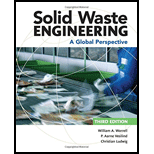
Concept explainers
(a)
To compare and evaluate : The percentage and total generation to national averages and report on the solid waste generated.
Explanation of Solution
The statement that includes a comparison of the total generation and percentage compared to the national averages is as below.
The national average of the waste above the percentage of the waste refuse produced by a single person in the house is
The weights of solid waste are classified below.
| Weight |
Per cent of the total weight | |
| Paper | ||
| Plastics | ||
| Aluminium | ||
| Steel | ||
| Glass | |
|
| Food | ||
| Other | ||
| Total | |
About
(b)
The amount of waste that is reusable and to identify the amount of waste that might be reduced.
Explanation of Solution
Glass waste can be reused in various ways such as mixing the glass powder with concrete for the replacement of sand. Since the demand for sand is more, glass powder can be used as a partial replacement for sand. Plastic bags can be used as plastic bottles; supply cups can be used for keeping pens, pencil and the plastic watering cans can be used as pots for gardening.
(c)
The various items in the refuse that is recoverable and to identify the process that is carried out.
Explanation of Solution
Recovery is defined as process by which the refuse can be converted into new products. Recovery of the materials such as waste plastic bottles can be converted to new plastic bottles, steel cans are converted to new steel cans, steel beams or recycled bicycles.
Want to see more full solutions like this?
Chapter 1 Solutions
Solid Waste Engineering
- A truck dumped industrial waste into a pit. They found the truck 3 days ago with a pure pool of waste. Your lab finds the BOD5 of this waste to be 80 mg/L with a k=0.1/day. What was the waste source? Here are the 3 nearby suspects: Winery BOD ultimate = 275 mg/L Vinegar manufacturer BOD ultimate = 80 mg/L Pharmaceutical BOD ultimate = 200 mg/Larrow_forwardWrite briefly about major factors affecting cost of Municipal solid waste collectionarrow_forwardWhere does the information on waste (waste in raw materials, waste in process and flow, etc.) come from? NOTE:PLEASE GIVE THE ANSWER WITHIN 2 HOURS THANK YOUarrow_forward
- Calculate the chemical composition of a typical yard waste with and without water (based on N and S). HINT: Assume 100 lb of waste, 40 % Moisture Contentarrow_forward1. What are the different approaches to solid waste management? What are the advantages and disadvantages of each approach? 2. What are the different types of solid wastes, and how are they identified? 3. How does the composition and management of solid waste vary around the world?arrow_forward7. The term ‘Municipal Solid Waste’ is used to describe which kind of solid waste? Select one: a. Toxic b. Non-toxic c. Hazardous d. Non-hazardousarrow_forward
- Please Elaborate on the topic of "Solid Waste Characteristics and Solid Waste Management"arrow_forwardThe City of Forty-Five (population 465,565) has requested your assistance in evaluating its solid waste collection system. Determine the mean time per collection stop plus the mean time to reach the next stop, the number of pickup locations per load, and the minimum number of trucks the city must own. The City of Forty-Five collection data are as follows: Average truck capacity = 12.5 m3; Average observed compaction ratio = 2.87 Crew size = 2; Number of pickups = 1 /wk (no rear-of-house service) Average number of cans per stop = 2.63/wk at 0.1136 m3/can Average number of residents per stop = 5 Average uncompacted density = 105.76 kg/m3 Average transport time to disposal site including delays and dumping = 1.78 h/trip Average number of trips to disposal site = 2/d; Rest breaks = 2 at 28.0 min Average maintenance downtime = 37.0 min/d; Average workday = 8.00 h Average percent of trucks out of service for major repairs = 15.0% Number of workday per week = 5arrow_forwardA writtine conclusion about solid waste, liquid waste and gastreous wastearrow_forward
- From the following date, estimate the unit waste disposal rate per week for a residentialarea consisting of 1200 homes. The average occupancy is 4 persons per home. Theobservation location is a local transfer station that receives all of the wastes collected fordisposal. The observation period was one week.Data:Number of compactor truck loads = 10Average size of compactor truck = 20 yd3Number of flatbed loads = 6Average flatbed volume = 3 yd3Number of loads from individual residents’ private cars and trucks = 20 Estimatedaverage volume per domestic vehicle = 9 ft3arrow_forwardwhat are the similarities in how liquid and solid waste is managed in chinaarrow_forwardWhat are the points of convergence and divergence in the approaches to waste management of hazardous and solid waste in the us? compare and contrastarrow_forward
 Solid Waste EngineeringCivil EngineeringISBN:9781305635203Author:Worrell, William A.Publisher:Cengage Learning,
Solid Waste EngineeringCivil EngineeringISBN:9781305635203Author:Worrell, William A.Publisher:Cengage Learning,
